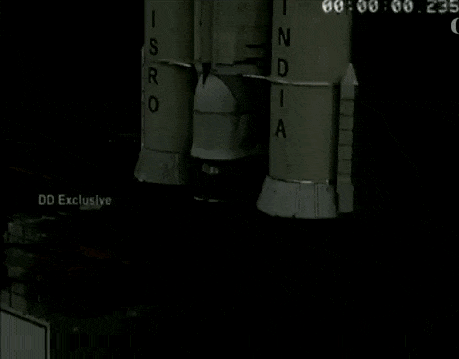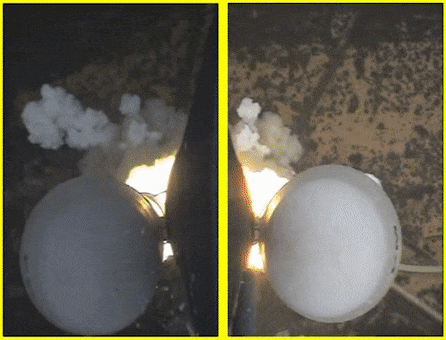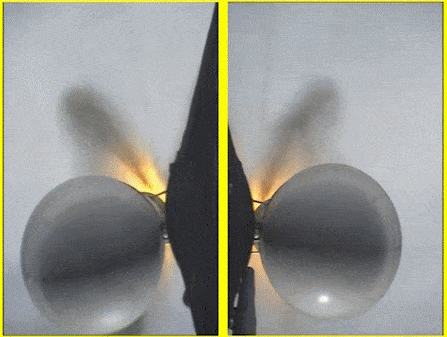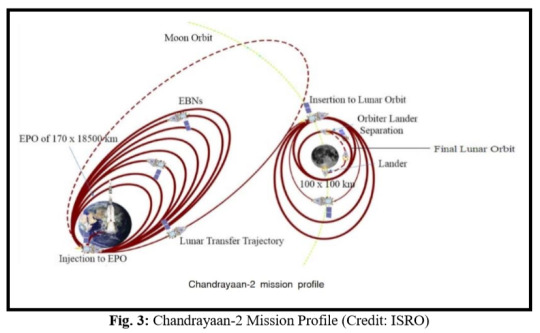#Chandrayaan2
Text
The Chandrayaan-2 orbiter captured Vikram Lander from space.

🚀 Get ready for an interstellar selfie! 📸 On September 6, 2023, something truly out-of-this-world happened. The DFSAR (Dual-frequency Synthetic Aperture Radar) aboard Chandrayaan-2 captured an epic snapshot of the Chandrayaan-3 lander, and guess what? DFSAR was chilling up in space on Chandrayaan-2, not on the lander itself. It's like a space selfie from one spaceship to another! 🛰️🌌But that's not all - DFSAR is no ordinary camera. It's a SAR (Synthetic Aperture Radar) tool that shoots out microwaves (think mini radio waves) to "see" things. The coolest part? It can do this even when there's no sunlight around, like a superhero camera with X-ray vision. 🦸♂️📷
0 notes
Text

Witness history in the making as India charts a new path to the moon! Charting a New Path to the Moon: Chandrayaan 2's Historic Launch is a moment of pride and scientific achievement, join us as we embark on an extraordinary journey of lunar exploration. Chandrayaan 2, equipped with cutting-edge technology, is set to unveil the moon's mysteries and expand our understanding of the universe. Let's celebrate the indomitable spirit of human curiosity and the relentless pursuit of knowledge. Together, we dare to reach for the stars and make groundbreaking discoveries in the realm of space exploration.
Visit at - http://bharulata.com/
#Chandrayaan2#MoonMission#ScientificAdvancement#HistoricLaunch#bharulata
0 notes
Link
Space exploration is an ambitious endeavor that pushes the boundaries of human knowledge and technological capabilities. However, it is not without its challenges, as demonstrated by India's Chandrayaan 2 mission, which unfortunately encountered obstacles and fell short of its intended objectives. Here we explore the key factors that contributed to the failure of the Chandrayaan 2 mission and the valuable lessons learned from this setback.
#chandrayaan#chandrayaanlaunch#chandrayaan2#chandrayaan3#isro#isroindia#isromissions#lunar mission#lunar exploration#indianinspace#india makes history#ksivan#ssomanath#newsprovider#newsprovidernetwork#vikramsarabhai#indian space research organisation#indian space#science
1 note
·
View note
Text

The brilliant minds at ISRO, are ready to continue their amazing journey toward the moon with hearts bursting with excitement and tenacity.
We send Team ISRO - Indian Space Research Organisation our warmest wishes as the nation stands together in support and awe. Your never-ending efforts have not only helped India's space program reach new heights, but they have also served as an example for future generations of would-be researchers and explorers.
#ClubCabana#Bangalore#Chandrayaan3#spacerocketeam#scientists#isromissions#isroindia#moonmission#chandrayaan2#spacetravel#teamisro#proudnation#prideofindia#nation#allthebest❤️#allthebest
0 notes
Text
Chandrayaan3 on the moon with Chandrayaan2:

408 notes
·
View notes
Text
i clearly remember watching chandrayaan2 failing it's landing and everybody crying on live television now everyone is celebrating. feels like an alternate reality. nicenice.
1 note
·
View note
Text
Watch "#isro #isroscientists #isroindia #isromissions #chandrayan3 #chandrayaan3 #chandrayaan3launch #india" on YouTube
0 notes
Text

GaursTheIsland
✅ #GaursTheIsland #presents #Luxurious #4Bhk & #5Bhk in #GreterNoida
✅ #Project With Mid to #High_rise #Apartments
✅ #Villas #Penthouses Are #Also #Available
✅ #Starting #from ₹ 4.8 Cr* #onwards
✅ #Visit: https://gaurisland.luxurypropertynoida.co
✅ #CallUs: 9899022675
ISROChandrayaan3 #Chandrayaan2, #isroscientists
0 notes
Text

Send from Sansgreet Android App. Sanskrit greetings app from team @livesanskrit .
It's the first Android app for sending @sanskrit greetings. Download app from https://livesanskrit.com/sansgreet
Chandrayaan-3 is a planned third lunar exploration mission by the Indian Space Research Organisation (ISRO). It will consist of a lander and a rover similar to Chandrayaan-2, but would not have an orbiter. Its propulsion module will behave like a communication relay satellite. The propulsion module will carry the lander and rover configuration until the spacecraft is in a 100 km lunar orbit.
#sansgreet #sanskritgreetings #greetingsinsanskrit #sanskritquotes #sanskritthoughts #emergingsanskrit #sanskrittrends #trendsinsanskrit #livesanskrit #sanskritlanguage #sanskritlove #sanskritdailyquotes #sanskritdailythoughts #sanskrit #resanskrit #moonmission #incredibleindia #chandrayaan2 #moondays #moon #moonlight #isro #moonwalker #moonmission #chandrayaan #chandrayan3 #proudbeanindian #moonwalk #moonphotography #celebratingsanskrit
1 note
·
View note
Link
#currentaffairs#latestcurrentaffairs#latestnews#latestupdate#solardriven#amazon#amazonCEO#whitehouse#ISRO#chandrayaan2#inoculateIndiaprogram#Typhoonhenri#Rhodeinland#Remembranceday#armedforce2021#neobolt#yuktahara#NSVishwanathan#currentaffairblog
4 notes
·
View notes
Text
In this video, we bring you exciting news from ISRO (Indian Space Research Organization)! Discover the latest groundbreaking mission on the moon with the Instrument for Lunar Seismic Activity (ILSA) on the Chandrayaan 3 Lander. Learn about how ILSA, utilizing cutting-edge Micro Electro Mechanical Systems (MEMS) technology, is recording vibrations caused by the Rover and other lunar payloads.
ILSA's primary mission is to detect and measure ground vibrations, including those caused by natural moonquakes, impacts, and human-made events. We'll share fascinating insights into the vibrations recorded during the Rover's navigation on August 25, 2023, as well as an intriguing event that appears natural, documented on August 26, 2023 – an event still under investigation by ISRO.

#Moonquake#Lunar Seismic Activity#ISRO's Discovery#Moon Exploration#Space Mission#Lunar Vibrations#Chandrayaan 3#MEMS Technology#Science Breakthrough#Space Science#Indian Space Research#Moon Mysteries#Space Technology#Moonquake Investigation#Lunar Rover#Space Exploration#Moon's Surface#Lunar Secrets#Moon Mission Updates#Moon Impact#Seismic Sensors#Space Science News#Lunar Mysteries Unveiled#ILSA#Instrument for Lunar Seismic Activity (ILSA)
0 notes
Photo






India launches first lunar lander, rover, on Chandrayaan-2 mission (July 22, 2019).
Closing out a week of historic lunar anniversaries, India’s space research organization, ISRO, attempted to make history of their own Monday morning with the launch of the Chandrayaan-2 lunar mission.
The spacecraft is part of the Indian Space Research Organization's, or ISRO, Chandrayaan lunar exploration program, which first saw an orbiter mission launch in 2008.
Chandrayaan-2 is a far more ambitious mission that includes three distinct spacecraft, an orbiter, lander, and rover. If successful, it will mark only the fourth time that a country has softly landed on the moon, behind Russia, the United States, and China.
The 5,244 pound Chandrayaan-2 orbiter will perform orbital measurements and serve as a communications link between ground controllers and the lander. Eight experiments will collect data on the lunar surface and environment, as well as surface mapping. Engineers estimate a one-year lifespan for the orbiter.
Named after the founder of Indian space program, the 3,183-pound Vikram lander carries three experiments to measure the Lunar surface, atmosphere, and interior. Additionally, Vikram will transport the mission’s third component, a small, six-wheeled rover named Pragyan.
Weighing in at just 60 pounds, Pragyan, which translates to wisdom in Sanskrit, will be India’s first mobile robotic explorer on another world. Its two science experiments will perform laser spectroscopy and X-ray spectrography. Pragyan will travel up to half a kilometer per day with a top speed of 1 centimeter per second. Engineers expect both the Vikram lander and Pragyan rover to operate for one lunar day, or two Earth weeks.

The combined Vikram lander/Pragyan rover, left, is seen integrating with the Chandrayaan-2 orbiter, right at the Satish Dhawan Space Center’s integration building prior to launch. P/c: ISRO
A long spiral to the Moon.
Liftoff occurred on the first scientific flight of India’s largest rocket, the GSLV-MkIII, which made its first flight in 2014. Liftoff occurred at 5:13am EDT, or 2:43pm India Standard Time, from the Second Launch Pad of the Satish Dhawan Space Centre in India.
Following separation of the rocket’s side boosters, core stage, and payload fairing, Chandrayaan-2 achieved Earth orbit 16 minutes after launch.
Chandaryaan-2 will use a low-energy flight profile for its voyage to the moon that will take up to 44 days to achieve its final orbit. The spacecraft will use its onboard engines to gradually rise its apogee – or furthest point in its orbit – performing a Lunar Orbit Insertion burn 30 days after liftoff.
The spacecraft will then spend the next 13 days gradually lowering its apogee to create a circular orbit 100 kilometers above the lunar surface. 48 days after liftoff, the Vikram lander with Pragyan inside is slated to touch down near the lunar south pole. ISRO Chairman Dr. K. Sivan expects the landing to occur on September 7.

Chandryaan-2 was originally a joint Indian-Russian mission slated to launch in 2011; financial woes, coupled with the high profile failure of the Phobos Grunt Mars mission with Europe ultimately caused Russia to pull out of the project. India’s commitment to complete the missions by themselves pushed the launch to 2018 and further technological hurdles ultimately caused the mission to be delayed to the first half of 2019.
Click here to see our GSLV launch vehicle archive.
youtube
P/c: ISRO.
207 notes
·
View notes
Photo

The Soviet Union, the United States and China are the only three countries to have successfully soft-landed on the moon. India is on track to join that select club with Chandrayaan 2.
51 notes
·
View notes
Photo





India Loses Contact with Vikram Lander During Historic Moon Landing Attempt
“ India lost contact with its Vikram lunar lander Friday (Sept. 6) during a daring attempt to make history as the first country to land near the south pole. The landing anomaly may have dashed Indian dreams of becoming just the fourth country to successfully soft-land a spacecraft on the moon. “
“Chandrayaan-2 consisted of three components — an orbiter, a lander named Vikram and a rover named Pragyan — which together launched to the moon on July 22 atop a Geosynchronous Satellite Launch Vehicle Mark III (GSLV Mk III) rocket. It took nearly 7 weeks to arrive at its destination; Chandrayaan-2 arrived in lunar orbit on Aug. 20, and the lander separated from the orbiter on Sept. 2 to begin its descent to the lunar surface.
The lander and the rover were designed to spend one lunar day — about 14 Earth days — investigating the lunar surface with a variety of scientific instruments. Both were expected to shutdown come nightfall at the moon's south pole, because they weren't built to withstand to frigid temperatures of the lunar night”.
“Despite the demise of the Pragyan lunar rover and Vikram lander, the Chandrayaan-2 orbiter will continue studying the moon from afar for about a year.”
space.com
46 notes
·
View notes
Photo

Take a look at the first Moon image captured by #Chandrayaan2 #VikramLander taken at a height of about 2650 km from Lunar surface on August 21, 2019.
Mare Orientale basin and Apollo craters are identified in the picture.
#ISRO
40 notes
·
View notes
Text
CHANDRAYAAN 2
Wish more people would talk about how the mission is 95% successful- India has just lost communication with the lander-which would have collected samples and would have been active for only 2 weeks.
The orbiter is successfully orbiting the moon currently and will be active for a year, and its life can be extended upto two years. It will be able to send information about the lander too, if it is still functional and if something can be done to save it.
Cheers to the scientists of ISRO!
India stands with you.
33 notes
·
View notes